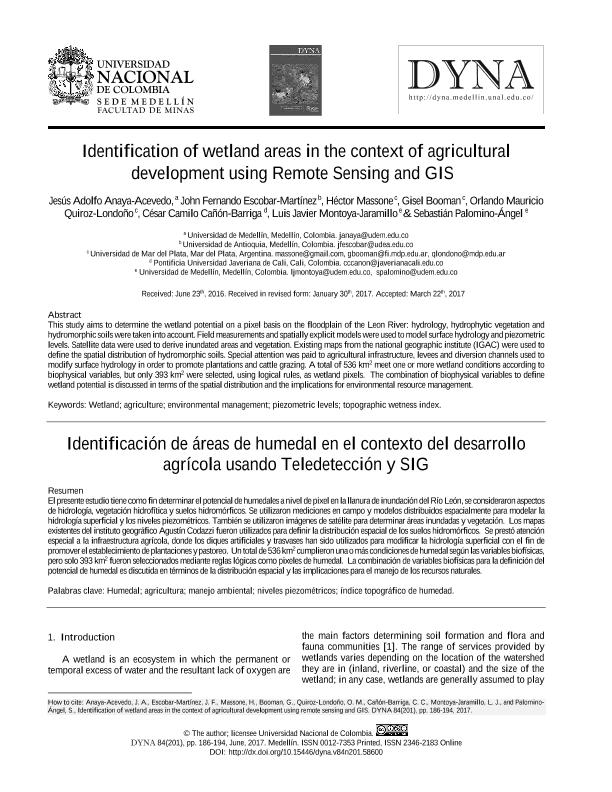Artículo
This study aims to determine the wetland potential on a pixel basis on the floodplain of the Leon River: hydrology, hydrophytic vegetation and hydromorphic soils were taken into account. Field measurements and spatially explicit models were used to model surface hydrology and piezometric levels. Satellite data were used to derive inundated areas and vegetation. Existing maps from the national geographic institute (IGAC) were used to define the spatial distribution of hydromorphic soils. Special attention was paid to agricultural infrastructure, levees and diversion channels used to modify surface hydrology in order to promote plantations and cattle grazing. A total of 536 km2 meet one or more wetland conditions according to biophysical variables, but only 393 km2 were selected, using logical rules, as wetland pixels. The combination of biophysical variables to define wetland potential is discussed in terms of the spatial distribution and the implications for environmental resource management. El presente estudio tiene como fin determinar el potencial de humedales a nivel de pixel en la llanura de inundación del Río León, se consideraron aspectos de hidrología, vegetación hidrofítica y suelos hidromórficos. Se utilizaron mediciones en campo y modelos distribuidos espacialmente para modelar la hidrología superficial y los niveles piezométricos. También se utilizaron imágenes de satélite para determinar áreas inundadas y vegetación. Los mapas existentes del instituto geográfico Agustín Codazzi fueron utilizados para definir la distribución espacial de los suelos hidromórficos. Se prestó atención especial a la infraestructura agrícola, donde los diques artificiales y trasvases han sido utilizados para modificar la hidrología superficial con el fin de promover el establecimiento de plantaciones y pastoreo. Un total de 536 km2 cumplieron una o más condiciones de humedal según las variables biofísicas, pero solo 393 km2 fueron seleccionados mediante reglas lógicas como pixeles de humedal. La combinación de variables biofísicas para la definición del potencial de humedal es discutida en términos de la distribución espacial y las implicaciones para el manejo de los recursos naturales.
Identification of wetland areas in the context of agricultural development using remote sensing and GIS
Título:
Identificación de áreas de humedal en el contexto del desarrollo agrícola usando teledetección y SIG
Anaya Acevedo, Jesús Adolfo; Escobar Martínez, John Fernando; Massone, Hector Enrique; Booman Zugarramurdi, Gisel Carolina ; Quiroz Londoño, Orlando Mauricio
; Quiroz Londoño, Orlando Mauricio ; Cañón Barriga, César Camilo; Montoya Jaramillo, Luis Javier; Palomino Ángel, Sebastián
; Cañón Barriga, César Camilo; Montoya Jaramillo, Luis Javier; Palomino Ángel, Sebastián
 ; Quiroz Londoño, Orlando Mauricio
; Quiroz Londoño, Orlando Mauricio ; Cañón Barriga, César Camilo; Montoya Jaramillo, Luis Javier; Palomino Ángel, Sebastián
; Cañón Barriga, César Camilo; Montoya Jaramillo, Luis Javier; Palomino Ángel, Sebastián
Fecha de publicación:
06/2017
Editorial:
Universidad Nacional de Colombia
Revista:
Dyna
ISSN:
0012-7353
e-ISSN:
2346-2183
Idioma:
Inglés
Tipo de recurso:
Artículo publicado
Clasificación temática:
Resumen
Archivos asociados
Licencia
Identificadores
Colecciones
Articulos(IIMYC)
Articulos de INSTITUTO DE INVESTIGACIONES MARINAS Y COSTERAS
Articulos de INSTITUTO DE INVESTIGACIONES MARINAS Y COSTERAS
Citación
Anaya Acevedo, Jesús Adolfo; Escobar Martínez, John Fernando; Massone, Hector Enrique; Booman Zugarramurdi, Gisel Carolina; Quiroz Londoño, Orlando Mauricio; et al.; Identification of wetland areas in the context of agricultural development using remote sensing and GIS; Universidad Nacional de Colombia; Dyna; 84; 201; 6-2017; 186-194
Compartir
Altmétricas



